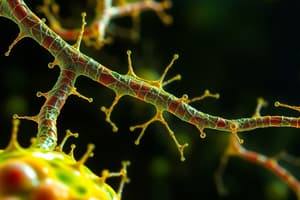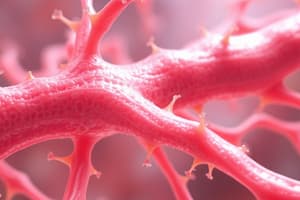Podcast
Questions and Answers
What is the purpose of direct cell-cell junctions?
What is the purpose of direct cell-cell junctions?
Creates pathways for communications, allows cells to exchange signals that coordinate their behavior, and regulates patterns of gene expression
What is the extracellular matrix composed of?
What is the extracellular matrix composed of?
Extracellular materials that cells secrete
What are the four functional classes of cell junctions in animal tissues?
What are the four functional classes of cell junctions in animal tissues?
Includes cell-cell junctions and cell-matrix adhesions, transmits stresses and is tethered to cytoskeletal filaments, seals the gap between cells, and creates passageways linking the cytoplasm of adjacent cells
What is the function of anchoring junctions?
What is the function of anchoring junctions?
What is the role of tight junctions?
What is the role of tight junctions?
What is the function of gap junctions?
What is the function of gap junctions?
What is an example of gap junction function in the nervous system?
What is an example of gap junction function in the nervous system?
What is the role of adherens junctions?
What is the role of adherens junctions?
What is the purpose of summarizing the various types of cell junctions?
What is the purpose of summarizing the various types of cell junctions?
Study Notes
Cell-Cell Adhesion and Junctions
- Cells cling to each other through two main ways: direct cell-cell junctions and extracellular matrix
- Direct cell-cell junctions:
- Create pathways for communication between cells
- Allow cells to exchange signals that coordinate their behavior
- Regulate patterns of gene expression
- Extracellular matrix:
- Composed of extracellular materials secreted by cells
- Controls the orientation of cells' internal structure
Functional Classes of Cell Junctions
- There are four functional classes of cell junctions in animal tissues
- These classes include both cell-cell junctions and cell-matrix adhesions
- Functions of these classes:
- Transmit stresses and are tethered to cytoskeletal filaments inside the cell
- Seal the gap between cells in the epithelia to create an impermeable barrier
- Create passageways linking the cytoplasm of adjacent cells
- Allow signals to be relayed from cell to cell across their plasma membranes
Specific Types of Cell Junctions
- Examples of cell junctions:
- Chemical synapses in the nervous system
- Immunological synapses, where T-lymphocytes interact with antigen-presenting cells
- Epithelial cells have specific types of cell junctions that play a crucial role in forming a barrier
Classification of Cell Junctions
- Cell junctions can be functionally classified into different types, as shown in Table 19-1
- This classification is important for understanding the roles of cell junctions in different tissues and cells.
Studying That Suits You
Use AI to generate personalized quizzes and flashcards to suit your learning preferences.
Description
This quiz covers the different ways cells adhere to each other, including direct cell-cell junctions and extracellular matrix. It also explores the functional classes of cell junctions in animal tissues.




